Introducción
En la era digital, ¿cómo podemos museos ¿Romper las limitaciones de las exhibiciones tradicionales y hacer que las reliquias culturales antiguas “vivan”?
¿Cómo pueden los visitantes no solo recorrerlos de forma superficial, sino también sumergirse plenamente en ellos? La aparición de las pantallas LED curvas ha traído una nueva solución a los museos.
Tabla de contenido
1. Análisis de las limitaciones de las exhibiciones museísticas tradicionales
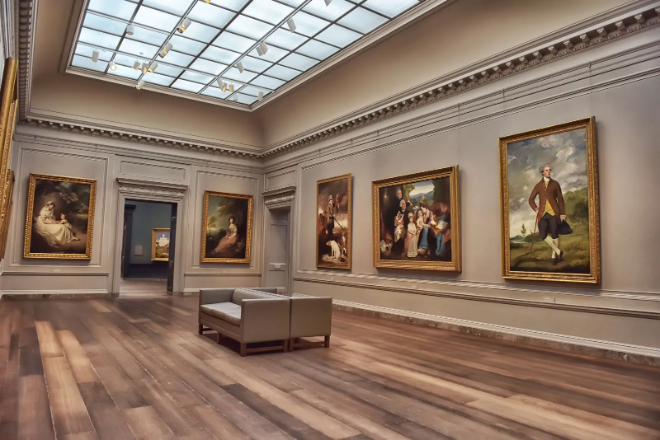
Los acontecimientos históricos son todos dinámicos, como las guerras antiguas, que requieren rutas de marcha y escenas de carga hacia la batalla.
Pero en los museos, solo hay unas pocas espadas y un mapa. Los visitantes solo pueden ver el aspecto de las armas, pero no pueden imaginar cómo las usaban los soldados para luchar ni la fiereza de la guerra.
También hay artesanías antiguas, como la cocción de cerámica, que es un proceso coherente desde el amasado del barro, el esmaltado hasta la cocción, pero en el museo solo se puede ver el producto terminado y el público no tiene idea de cómo se hace paso a paso.
Hoy en día, a todo el mundo, especialmente a los jóvenes, le gustan las cosas divertidas e interesantes.
Sin embargo, en los museos, las exhibiciones se colocan en vitrinas y los visitantes solo pueden observarlas desde la distancia. Esta visión pasiva puede aburrir fácilmente a la gente.
Por ejemplo, al observar reliquias culturales antiguas, los visitantes pueden simplemente echar un vistazo casual y no querer aprender más sobre las historias detrás de ellas, porque no hay nada que pueda atraerlos a explorar activamente.
La gente se apoya en la vista, el oído, la nariz y las manos para comprender. Sin embargo, en los museos tradicionales, los visitantes solo pueden ver con los ojos.
Por ejemplo, si se pueden tocar instrumentos musicales antiguos en vivo, el público definitivamente podrá sentir mejor el encanto de la música antigua.
También hay reliquias culturales con olores especiales, como las especias. Si puedes olerlas, la sensación será definitivamente diferente. Pero en el museo, solo puedes mirarlas, y los demás sentidos son completamente inútiles.
El espacio para texto e imágenes en los paneles de exposición del museo es limitado, por lo que solo se pueden escribir cosas sencillas, como el nombre de la reliquia cultural, su antigüedad y dónde fue desenterrada.
Pero hay muchas historias detrás de las reliquias culturales, como cómo se hicieron, cómo las usaba la gente en ese momento y las personas y las cosas relacionadas con ellas, que no se pueden explicar en detalle.
Por ejemplo, un antiguo artefacto de jade puede representar el estatus social y las creencias religiosas de la época, pero el método de exhibición tradicional solo puede indicar de qué material y forma está hecho, y los demás contenidos no se pueden explicar con claridad.
El método de visualización tradicional implica principalmente texto e imágenes, lo cual es muy aburrido.
En el caso de algunas cuestiones complejas, como la estructura social y los rituales religiosos de la antigüedad, resulta difícil que la gente las comprenda únicamente con texto e imágenes.
Además, este método no es adecuado para diferentes tipos de público. Algunos prefieren escuchar historias y otros necesitan una experiencia práctica, pero el método de visualización tradicional no satisface estas necesidades.
2. Ventajas técnicas de la pantalla LED curva
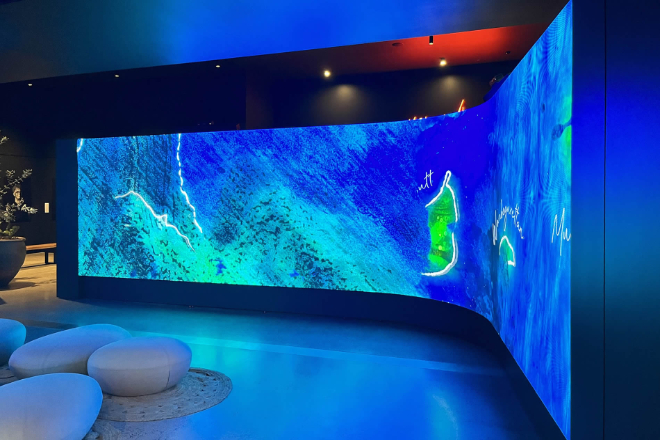
1) Avance en efectos visuales
La pantalla curva es como “doblar” la pantalla y el campo de visión se vuelve más amplio de repente, lo que parece muy cómodo, a diferencia de la pantalla plana tradicional que es tan “dura”.
por ejemplo, el gran pantalla LED En la entrada del Museo Canadiense de Ciencia y Tecnología hay una curva que no solo luce genial, sino que también se adapta perfectamente a la forma del edificio.
Esta pantalla tiene una resolución súper alta. resolución, que muestra con claridad los detalles de reliquias culturales y escenas históricas. Como si se observara con una lente de alta definición, incluso los detalles más pequeños se pueden ver con claridad.
2) Creando una experiencia inmersiva
La pantalla curva es como una “burbuja visual” que envuelve al público en su interior, haciéndoles sentir como si realmente hubieran entrado en esa escena.
Por ejemplo, el Pabellón de Finlandia en la Expo de Dubái cuenta con una enorme pantalla LED curva. Cuando el público se sitúa frente a ella, siente como si estuviera rodeado de bosques y lagos nórdicos.
Combinado con imágenes dinámicas y efectos de sonido, como la reproducción de imágenes de olas con el sonido de las mismas, te sientes como si estuvieras en la playa.
Hay una pantalla 3D a simple vista en el tejado de SMTown en Seúl, Corea del Sur.
Al reproducir el vídeo de las olas con efectos de sonido 3D, los transeúntes sienten como si estuvieran a punto de ser arrastrados por las olas, lo que es muy realista.
3) Flexibilidad y personalización
La pantalla LED curva es particularmente “flexible” y se puede personalizar según el tamaño, la forma y los requisitos de visualización de la sala de exposiciones.
No importa la complejidad de la forma, se puede manipular. Esta pantalla también permite cambiar entre múltiples modos de visualización.
Por ejemplo, en el MSG Sphere de Las Vegas, la pantalla LED esférica interior puede cambiar de contenido según las diferentes actividades. A veces es un concierto, a veces una exposición de tecnología, lo cual resulta muy práctico.
3. El papel de las salas de exposiciones inmersivas en la promoción de la comunicación cultural
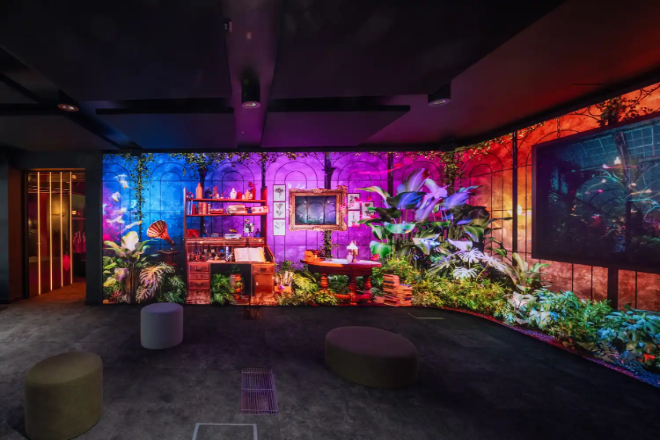
1) Estimular el interés de la audiencia
La sala de exposiciones inmersiva es como una “caja mágica” llena de cosas divertidas y bellas, y el público se siente atraído de inmediato.
Por ejemplo, en las salas de exposiciones inmersivas de algunos museos, el público puede entrar en una escena histórica virtual y sentir que está viajando a través del tiempo y el espacio.
Esta vívida forma de exhibición permite al público explorarla activamente en lugar de simplemente mirarla desde la distancia como antes.
De esta manera, la atención de la audiencia hacia las reliquias culturales y la cultura histórica aumentará naturalmente y el efecto de la comunicación cultural será mejor.
2) Mejorar educativo funciones
En la inmersión exhibición En esta sala, el público no solo puede mirar, sino también operar e incluso interactuar con la escena.
Por ejemplo, algunas salas de exposiciones ofrecen experiencias arqueológicas virtuales, donde el público puede desenterrar reliquias culturales por sí solo y aprender sobre el conocimiento previo de dichas reliquias a través de pantallas interactivas.
Esta experiencia interactiva facilita que el público comprenda y recuerde el conocimiento histórico y es adecuada para personas de todas las edades y niveles de conocimiento.
Tanto niños como adultos pueden divertirse en la sala de exposiciones inmersiva y el público educativo del museo se ha ampliado.
3) Mejorar la profundidad y amplitud de la comunicación cultural.
Las salas de exposiciones inmersivas pueden mostrar las connotaciones y el contexto de la cultura de forma más completa.
Por ejemplo, a través de la proyección 3D, la realidad virtual y otras tecnologías, el público puede obtener una comprensión en profundidad del proceso de producción y los escenarios de uso de las reliquias culturales.
Incluso se relacionan historias históricas, mejorando así la profundidad de la comunicación cultural.
Además, muchos visitantes ahora comparten sus experiencias en las redes sociales después de visitar la sala de exposiciones inmersivas, lo que atrajo a más personas a visitar el museo y, naturalmente, la amplitud de la comunicación cultural se expandió.
4. Cómo utilizar una pantalla LED curva en una sala de exposiciones inmersiva
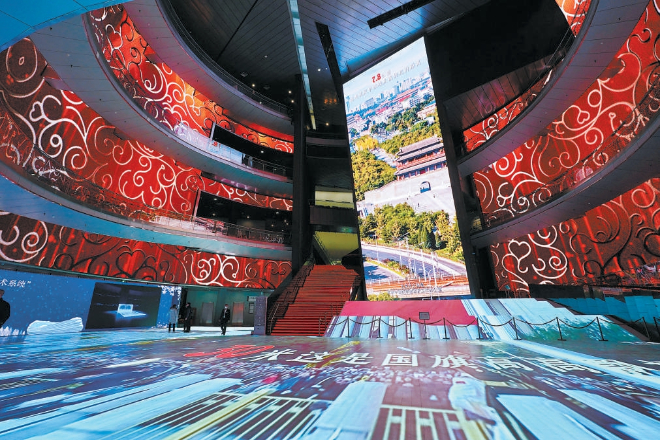
1) Reproducción de escenas históricas
Imagínate que entras en una sala de exposiciones y de repente te encuentras parado en la antigua arena romana, rodeado de multitudes que vitorean y escuchando los gritos de los gladiadores.
¡Este es el encanto de las pantallas LED curvas! Pueden reproducir escenas como características de ciudades antiguas y eventos históricos, haciendo que el público parezca viajar a través del tiempo y el espacio.
Por ejemplo, en un museo histórico de Roma, Italia, se reprodujeron las calles y la arena de la antigua Roma con pantallas LED curvas, y el público sintió que realmente había regresado a esa época.
Combinado con la tecnología de realidad virtual, el uso de gafas VR hace que la sensación de realidad e inmersión sea aún más fuerte, como si fueras parte de la historia.
2) Exhibición e interpretación de reliquias culturales
En la exhibición de reliquias culturales tradicionales, el público sólo puede observar desde la distancia y muchos detalles no están claros.
Pero la pantalla LED curva puede mostrar dinámicamente reliquias culturales, presentándolas desde diferentes ángulos, para que el público pueda ver cada detalle con claridad.
Por ejemplo, en una exposición en el Museo Metropolitano de Arte de Nueva York, se exhibió una máscara de faraón del antiguo Egipto sobre una pantalla curva.
La pantalla puede girar 360 grados para su visualización, y el público también puede hacer zoom en los detalles para ver los tallados y las piedras preciosas.
Al mismo tiempo, la pantalla también puede cooperar con explicaciones y funciones interactivas.
Por ejemplo, al hacer clic en la pantalla, puede ver la historia detrás de las reliquias culturales y comprender su contexto histórico y valor cultural.
3) Exposiciones temáticas y experiencias interactivas
Hoy en día, es cada vez más popular que los museos realicen exposiciones temáticas, como arte antiguo, cultura popular, etc.
Las pantallas LED curvas pueden crear salas de exposiciones temáticas inmersivas para hacer la exposición más atractiva.
Por ejemplo, en una exposición temática sobre mitología griega en el Museo Británico de Londres, la sala de exposiciones fue diseñada como un templo griego virtual, donde el público puede entrar y sentir la atmósfera de la mitología griega.
Además, en la sala de exposiciones se han diseñado numerosos enlaces interactivos, como por ejemplo arqueología virtual y restauración de reliquias culturales.
El público puede participar. Por ejemplo, al usar herramientas virtuales para excavar reliquias culturales o reparar cerámica rota, esta sensación de participación enriquece enormemente la experiencia del público.
5. La pantalla LED curva mejora la imagen de marca del museo.
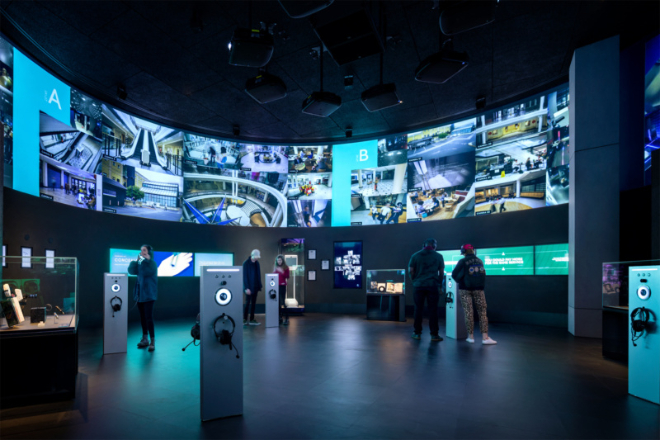
1) La encarnación de la tecnología y la modernidad.
Con la pantalla LED curva, ¡el museo se vuelve al instante un lugar de alta gama! Esta pantalla es muy atractiva y está llena de tecnología y modernidad.
Por ejemplo, el Louvre de París utilizó pantallas LED curvas en algunas exposiciones temporales, que combinaban perfectamente los sentimientos antiguos y modernos.
Esto no sólo muestra el uso de tecnología moderna por parte del museo, sino que también hace que el museo parezca más “moderno” y más innovador.
Esta imagen es especialmente atractiva para los jóvenes. Les gustan las cosas nuevas y divertidas. Al ver que el museo es tan "cool", es natural que quieran venir más veces.
2) Mejorar la satisfacción de la audiencia y el boca a boca.
¡El público entra en la sala de exposiciones inmersiva y vive una gran experiencia!
Por ejemplo, en la exposición de dinosaurios del Museo de Historia Natural de Londres, se utilizó una pantalla LED curva para recrear la escena de la vida de los dinosaurios y el público sintió como si hubiera regresado a la era Jurásica.
Esta experiencia de alta calidad deja al público particularmente satisfecho. No solo están felices, sino que también la compartirán en redes sociales y se la contarán a sus amigos y familiares.
La buena comunicación de boca en boca es como “publicidad gratuita” que puede aumentar rápidamente la popularidad y la influencia del museo.
3) Mejorar la competitividad del museo
Actualmente, hay muchísimos museos y la competencia es feroz. Con una pantalla LED curva, el museo puede destacar entre la competencia.
Por ejemplo, el Museo Van Gogh de Ámsterdam utilizó esta pantalla para mostrar las pinturas y las historias de vida de Van Gogh, atrayendo a un gran número de turistas.
Este método de exhibición único no sólo puede atraer más turistas, sino que también genera más recursos, como patrocinadores y proyectos de investigación.
De esta manera, el desarrollo sostenible del museo tiene una base más sólida.
6. Conclusión
A través de la pantalla LED curva, el museo ha pasado de la tradicional exhibición estática a una experiencia interactiva inmersiva, que no solo hace que las reliquias culturales “cobren vida”, sino que también saluda al público.
Este innovador método de exhibición no sólo mejora la imagen de marca del museo, sino que también hace que la comunicación cultural sea vívida y profunda.
Finalmente, si quieres saber más sobre las pantallas LED, Por favor póngase en contacto con nosotros.
